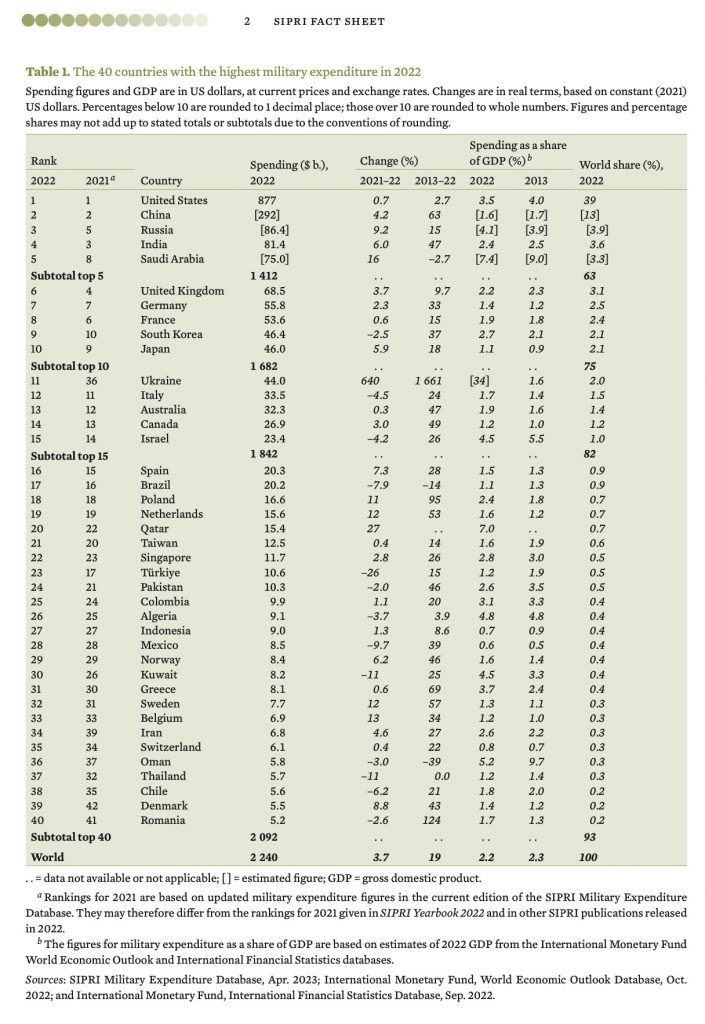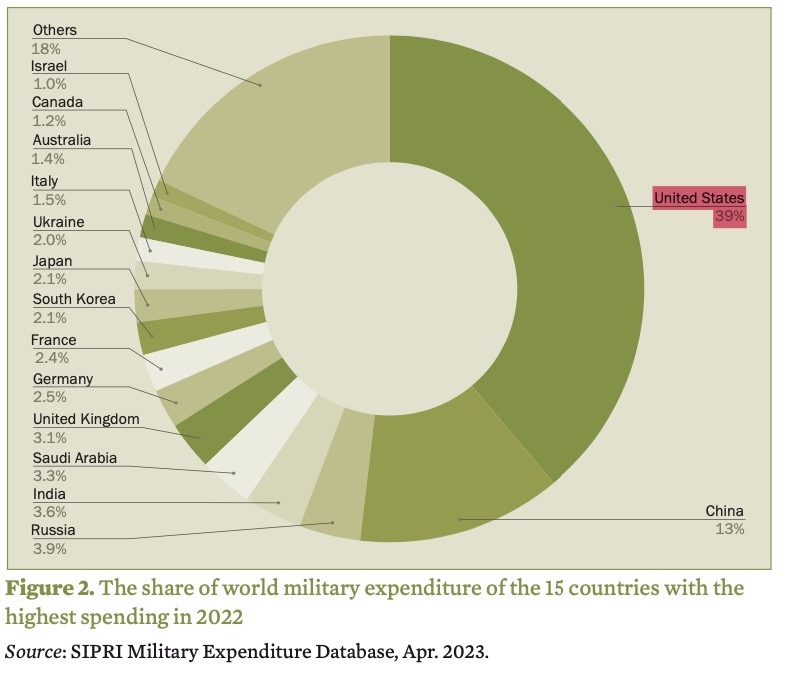26 Apr 2023
As wars rage, tourism suffers, the arms bazaar prospers
Bangkok — On 24 April, the Stockholm International Peace Research Institute (SIPRI) released its annual report on global military expenditure. It makes shocking reading. Even as the world grapples with poverty, climate change, health pandemics, natural disasters and struggles to revive jobs and economic growth, total global military expenditure increased by 3.7% in real terms in 2022, to reach a new high of $2,240 billion. The United States alone comprised 39%, a total of US$877 billion.
It was the eighth consecutive year of growth, since 2014, which means that even though the Covid-19 pandemic stagnated the global economy, nearly killed tourism and poor countries struggled to pay for vaccines, the arms bazaar continued to rake it in. Just as the pandemic tapered off in early 2022, the Russia-Ukraine war and rising tensions in East Asia led to another spurt in spending by Europe, China and Japan.


The SIPRI press release quoted Dr Nan Tian, Senior Researcher with SIPRI’s Military Expenditure and Arms Production Programme, as saying, “The continuous rise in global military expenditure in recent years is a sign that we are living in an increasingly insecure world. States are bolstering military strength in response to a deteriorating security environment, which they do not foresee improving in the near future.’
SIPRI military expenditure data includes all current and capital expenditure on: (a) the armed forces, including peacekeeping forces; (b) defence ministries and other government agencies engaged in defence projects; (c) paramilitary forces, when judged to be trained and equipped for military operations; and (d) military space activities. It also includes salaries of military and civil personnel and pensions and social services of military personnel—as well as expenditure on operations and maintenance, procurement, military research and development and military aid. It does not cover civil defence, veterans’ benefits, demobilization, conversion, weapon destruction and military involvement in nonmilitary activities.
According to the SIPRI report, U.S. military expenditure in 2022 was three times more than China’s, the world’s second largest spender. This was largely accounted for by the unprecedented $19.9 billion in financial military aid to Ukraine, according to Dr Nan Tian, SIPRI Senior Researcher. This was the largest amount of military aid given by any country to a single beneficiary in any year since the cold war.
In 2022 the U.S. allocated $295 billion to military operations and maintenance, $264 billion to procurement and research and development, and $167 billion to military personnel.
The United Kingdom had the highest military spending in Central and Western Europe at $68.5 billion, of which an estimated $2.5 billion (3.6%) was financial military aid to Ukraine.
In Asia and Oceania, the military expenditure of $575 billion was 2.7% more than in 2021 and 45% more than in 2013, continuing an uninterrupted upward trend dating back to at least 1989.
China allocated an estimated $292 billion in 2022. This was 4.2% more than in 2021 and 63% more than in 2013. China’s military expenditure has increased for 28 consecutive years.
Japan’s military spending increased by 5.9% between 2021 and 2022, reaching $46.0 billion, or 1.1% of GDP. This was the highest level since 1960. More money is on the way. According to SIPRI, a new national security strategy published in 2022 sets out ambitious plans to increase Japan’s military capability over the coming decade in response to perceived growing threats from China, North Korea and Russia.
India’s military spending of $81.4 billion was the fourth highest in the world. It was up 6% over 2021.
In 2022 military spending by Saudi Arabia, the fifth biggest military spender, rose by 16% to reach an estimated $75.0 billion, its first increase since 2018.
Even poor countries are spending more. Ethiopia’s military spending rose by 88% in 2022, to reach $1.0 billion. The increase coincided with a renewed government offensive against the Tigray People’s Liberation Front in the north of the country.
Several countries reported a decline in expenditure.
Türkiye’s military spending fell for the third year in a row, reaching $10.6 billion — a decrease of 26% from 2021. Of the 40 top spenders, Thailand and Kuwait recorded the second largest percentage cuts respectively -11% to US$5.7 billion and US$8.2 billion. Other countries which slashed their military expenditure were: South Korea, Brazil, Algeria, Pakistan, Mexico, Oman, Chile and Romania.
This data takes on greater importance when examined in a broader context. Several questions arise, arise especially when related to Travel & Tourism:
(+) Given the fact that the military-industrial complex feeds on wars and conflict, is there any light at the end of the tunnel? Indeed, it’s a never-ending spiral. The more one country spends, the greater the threat perceived by its neighbours, and the more they too have to spend.
(+) All the global conflict areas in Europe, Asia and the Middle East involved the United States in some way. Is the policy of “forever wars” here to stay?
(+) The war in Europe is supposed to be between Russia and Ukraine. This report proves that it is a proxy war between the U.S./NATO and Russia, with Ukraine getting caught in the middle. As the superpowers are now battling each other, how long will it go on? What will be the cost in human life, material destruction and the geopolitical fallout?
(+) Which companies are profiting? They make obscene amounts of money regardless of which side wins or loses. Are their financial statements analysed to see how wars and conflict bolster their bottom lines and share prices?
(+) Where’s the transparency? How much is spent on what? Missiles? Ships? Tanks? Aircraft? Drones? Personnel? R&D?
(+) What other wider powers do the global militaries wield? Do they fund political parties? Instigate and finance regime-change operations? Spy on people?
(+) What is the environmental impact of the arms bazaar? Not only do weapons require copious quantities of Rare Earth minerals, who monitors their emissions and contribution to global warming?
(+) How much global conflict is driven by the need to create jobs for the military-industrial complex? A lot of outdated equipment is being offloaded for civilian use. Retired personnel become security consultants or sit on the boards of the weapons manufacturers.
(+) What is the cost in terms of human suffering, and the direct and indirect damage done to humanity?
(+) Would it make the world more peaceful if military budgets are slashed and diverted to achieving the UN Sustainable Development Goals in the little time there is left?
(+) There is no parallel record of Travel & Tourism industry budgets. Would it be useful to start an annual monitoring system as a comparative yardstick to the military budgets? The huge gap would be a shock to the system.
(+) Why do Travel & Tourism forums ignore these obscene amounts? Can Travel & Tourism truly claim to be an “industry of peace” if it sweeps the impact of wars and conflict under the carpet? Why does the industry continue to harp on crisis management and resilience when it should be focussing on preventing wars and conflict in the first place?
